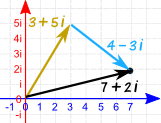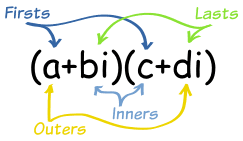Either Part Can Be Zero
So, a Complex Number has a real part and an imaginary part.But either part can be 0, so all Real Numbers and Imaginary Numbers are also Complex Numbers.
| Complex Number | Real Part | Imaginary Part |
|---|---|---|
| 3 + 2i | 3 | 2 |
| 5 | 5 | 0 |
| −6i | 0 | −6 |
Complicated?

It means the two types of numbers, real and imaginary, together form a complex, just like a building complex (buildings joined together).
A Visual Explanation
You know how the number line goes left-right?Well let's have the imaginary numbers go up-down:
And a complex number can now be shown as a point:

The complex number 3 + 4i
Adding
To add two complex numbers we add each part separately:
(a+bi) + (c+di) = (a+c) + (b+d)i
Example: add the complex numbers 3 + 2i and 1 + 7i
- add the real numbers, and
- add the imaginary numbers:
(3 + 2i) + (1 + 7i)
= 3 + 1 + (2 + 3)i
= (4 + 9i)
= 3 + 1 + (2 + 3)i
= (4 + 9i)
Example: add the complex numbers 3 + 5i and 4 − 3i

(3 + 5i) + (4 − 3i)
= 3 + 4 + (5 − 3)i
= 7 + 2i
= 3 + 4 + (5 − 3)i
= 7 + 2i
Multiplying
To multiply complex numbers:
Each part of the first complex number gets multiplied by
each part of the second complex number
Just use "FOIL", which stands for "Firsts, Outers, Inners, Lasts" (see Binomial Multiplication for more details):each part of the second complex number
 |
|
(a+bi)(c+di) = ac + adi + bci + bdi2
| |

No comments:
Post a Comment